

Teaching Tools In a Flash Jigsaw Final. Jigsaw - STRATEGIES. JIGSAWDefinition/Description: Jigsaw is a cooperative learning strategy that enables each student to become an expert on a certain topic, through communication and discussion with others reading the same text, researching the same topic or unit, and then share their findings to their original “home” group.
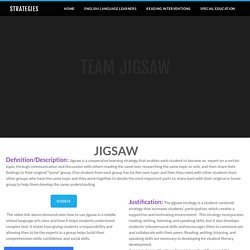
One student from each group has his/her own topic and then they meet with other students from other groups who have the same topic and they work together to decide the most important parts to share back with their original or home group to help them develop the same understanding. Differentiated instruction"Give students experience with small group learning skills before participating in the jigsaw strategy.Have students fill out a graphic organizer in the "home group" to gather all the information presented by each "expert. "" Additional Links for: Information, Lessons, and Material. Lecture vs. Active Learning: Reframing the Conversation. Implementing Active Learning and Student-Centered Pedagogy in Large Classes. Active Learning: Changed Attitudes and Improved Performance. Simple Techniques for Applying Active Learning Strategies to Online Course Videos. Simple Techniques for Applying Active Learning Strategies to Online Course Videos.
Course Redesign Finds Right Blend of Content Delivery and Active Learning. Active Learning: In Need of Deeper Exploration. Deeper Thinking about Active Learning. Looking for ‘Flippable’ Moments in Your Class. Three Active Learning Strategies You Can Do in 10 Minutes or Less. Five Ways to Engage Students in an Online Learning Environment. Three Active Learning Strategies. The 5 Best Free Cartoon Making Tools For Teachers. EJ1000091. Simulations and Serious Gaming-Resources for Design and Use in the Higher Education Classroom Resources in Game Design / Serious Gaming. 7 Things You Should Know About Virtual Labs. Virtual labs are interactive, digital simulations of activities that typically take place in physical laboratory settings.
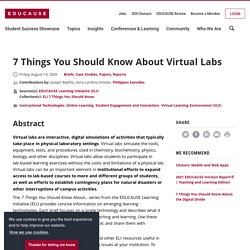
Virtual labs simulate the tools, equipment, tests, and procedures used in chemistry, biochemistry, physics, biology, and other disciplines. Virtual labs allow students to participate in lab-based learning exercises without the costs and limitations of a physical lab. Virtual labs can be an important element in institutional efforts to expand access to lab-based courses to more and different groups of students, as well as efforts to establish contingency plans for natural disasters or other interruptions of campus activities. Virtual and Remote Labs – Pegasus Innovation Lab. Welcome!
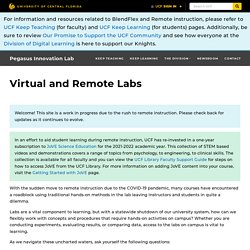
This site is a work in progress due to the rush to remote instruction. Please check back for updates as it continues to evolve. In an effort to aid student learning during remote instruction, UCF has re-invested in a one-year subscription to JoVE Science Education for the 2021-2022 academic year. This collection of STEM based videos and demonstrations covers a range of topics from psychology, to engineering, to clinical skills.
Second Life - Virtual Worlds, Virtual Reality, VR, Avatars, Free 3D Chat. Problem-Based Learning: An Overview of its Process and Impact on Learning. Essential Readings in Problem-based Learning - Google Books. View of Problem-based Learning in an Online Course: A case study. Institute for Transforming University Education. 7 Must-Have Problem Based Learning Apps, Tools and Resources. Problem Based Learning (PBL) can radically change student learning.
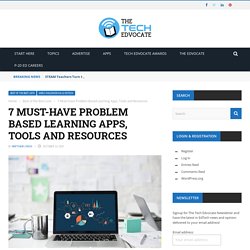
Rather than stuff students full of facts or material to memorize, problem based learning encourages students to solve problems independently (or in groups) to find solutions. Additionally, problem based learning is student-centered, which is where all of education is headed. PBL ESD Case Study Bessant, et al. 2013. Group projects in online classes create connections and challenge instructors.
Group work has long been a source of friction between students and instructors. At their worst, team projects force high-achieving students to compensate for those less willing to put in effort. At their best, they foster productive collaboration and idea sharing among future professionals. Online courses add another layer of considerations for instructors. Harvard Business Publishing Education.
Moodle. Learning within the online environment, often termed as "eLearning", differs from the traditional classroom learning community.

Unlike traditional classroom learning opportunities, online learning environments foster additional learning experiences where learners can interact, collaborate, and take ownership of their own learning. Developing effective collaborative online activities begins with understanding the research and how learners process information when online. Educators of online learning environments must focus on instructional and pedagogical best practices in order to deliver effective online instruction. Virtually Inspired: Showcasing Online Learning Innovation. 15 AR and VR Immersive Learning Tools. There are many different tools available to educators today that help to put learning in students’ hands.
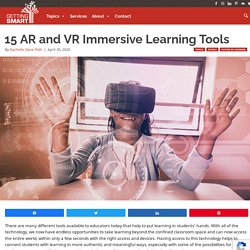
With all of the technology, we now have endless opportunities to take learning beyond the confined classroom space and can now access the entire world, within only a few seconds with the right access and devices. Having access to this technology helps to connect students with learning in more authentic and meaningful ways, especially with some of the possibilities for students to engage with the content through the use of augmented and virtual reality tools. When it comes to these more immersive technologies, figuring out where to start can feel overwhelming. However, as with all methods and tools, when thinking about bringing technology to our classrooms, we always want to focus on the purpose. Start with some clear goals for what it’s going to help our students do differently and how it’s going to positively impact their educational experience. You searched for active learning. Active Learning while Physically Distancing.
Moodle. The AR experience is thriving as a significant trend, and it is estimated that by 2023 there will be 2.4 billion Augmented Reality mobile users worldwide.
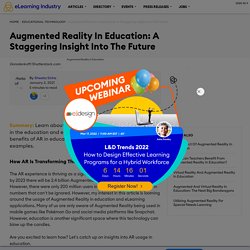
However, there were only 200 million users in 2015. It is an excellent influx in numbers that can't be ignored. From VR and AR to Our XR Future: Transforming Higher Education. As we wrap up the Immersive Learning series, we want to highlight the changing technology landscape, revisit the ethical issues we will confront, explore the impact on learning, and glance into the future. More than a year ago, we started the Immersive Learning series as a way to continue the conversation sparked by multiple workshops and an EDUCAUSE Learning Initiative (ELI) webinar we co-presented titled "Virtual and Augmented Reality: Stepping Into the New Frontier of Learning. " The series highlighted the emerging developments around virtual reality (VR) and augmented reality (AR) and encouraged further exploration from the higher education community. Since the series began, a number of institutions have launched immersive projects, while others are developing VR and AR labs.
The interest and experimentation around these developments continue to grow, as we've seen in the recent ELI online event "eXtended Reality (XR): How AR, VR, and MR Are Extending Learning Opportunities. " 40+ FREE digital escape rooms (plus a step by step guide for creating your own) Escape rooms are a fun adventure where you solve puzzles to escape from the room in a short amount of time.
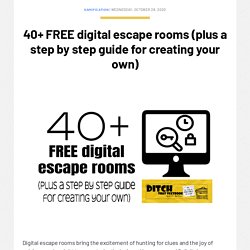
I love creating physical escape rooms in my classroom. They are fun and they get the students up and moving in the classroom. Gamification and Game-Based Learning. Active-Learning Theories (constructivism,...) and Teaching Strategies. What is active learning, and when does it happen?

Whenever experiences stimulate mental activities that lead to meaningful learning, this is active learning. Mentally active learning of ideas-and-skills can occur in a wide variety of thought-stimulating activities, ranging from direct learning (of ideas that are explained in a web-page, book, lecture, video, tv or radio show,...) to learning by discovery (as in doing an experiment and then trying to discover your own explanations for what has been observed), or in design projects and other kinds of problem solving where the learning cannot be defined as either direct or discovery.
Teaching with Technology: Tools and Strategies to Improve Student Learning.